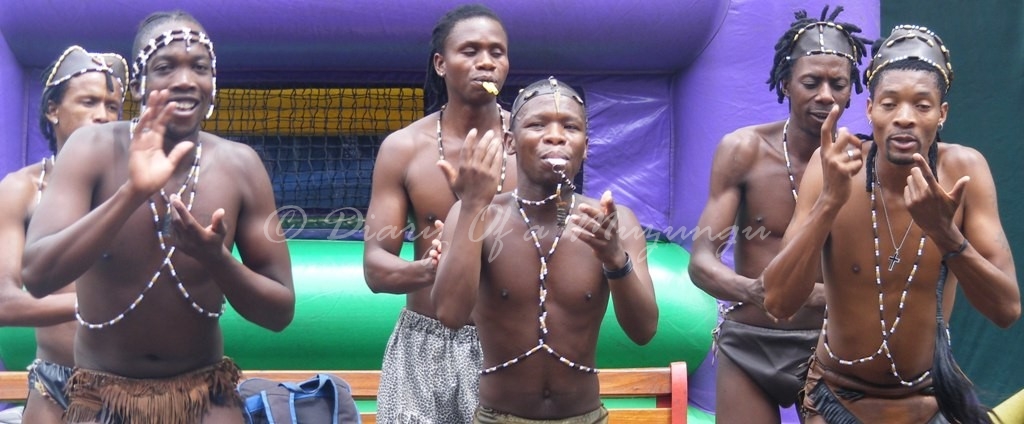
There is a feeling of space in suburban northern Johannesburg, by far the largest city in South Africa. The plots are big, the streets are lined with large beautiful trees and the treetops are full of the sound of birdsong. There are three big Hadeda Ibis on the chimney stack, a Crested Barbet appears by the dining-room window and the enormous and noisy Grey Louries or “Go Away birds” clamber about in the treetops and swoop low with floppy wingbeats.
Now on my second visit, I have become used to the high walls, the electric fencing and the electric security date.
I notice more people on the street this time around, particularly kids laughing and shouting on the way home from school. House staff sit and chat on street corners, male runners are accompanied by dogs. At clean and orderly road junctions, people sell Zulu beaded statues of lions, zebra and chameleons. The beggars seem friendly enough too.
PHOTO: Sex and shopping? Oh if you insist! Rosebank sunday market. The Zulu people have traditionally used beads as a means of communication especially as love letters. Colours and arrangement of the beads convey the message. Deep blue for example portrays elopement because it refers to the flight of the Ibis. Green is a good sign: it stands for peace or bliss.
Apart from H’s parting shot as she went out the other day “you do know where the panic button is don’t you?” I feel quite unperturbed.
H lives in Parkview. Shopping malls at Rosebank, Hyde Park and Craig Hall Park are close by. “Not another shopping mall!” I moan to H one day – even the Montecasino Bird Park is part of a shopping mall. In this paranoid part of the world, they make sense. Security is easier to manage but I have always hated enclosed shopping malls. It would be wrong to say this is not the real Jo’burg, but I feel it is only one version of it.
Perhaps unkindly, the 1998 Lonely Planet guide states:
“The northern suburbs of white middle-class ghettos – this is where you want to go if you want to pretend you’re not in Africa. White people driving Mercs and BMWs rush to busy antiseptic shopping centres and the only blacks are neatly uniformed maids and gardeners waiting for minibus taxis. There is little communal life although scattered about you find many of the city’s best restaurants and shops.”
The food is indeed fantastic, such a variety, so fresh and colourful. The large amounts of cash and diversity of immigrants in Johannesburg make for a good culinary combination. H spoils me at every opportunity. I sit drooling over another menu, savouring the choice and in no rush to order: white wine, halloumi, calamari, raspberry jam, lemon meringue pie for god’s sake! smoked salmon, egg’s Benedict, veggie shepherd’s pie. I AM IN HEAVEN. It’s such an antidote to the lacklustre cooking I’m used to in Uganda. I do not miss matoke.
In stark contrast to where she lives, H works in Hillbrow in central Johannesburg. The same 1998 Lonely Planet guide states: “Although large-scale outbreaks of violence are things of the past violent crime is still rampant especially in the centre and the Hillbrow area.” How those words must have stuck in H’s mind when she arrived in Jo’burg with VSO hmmmm, when was it – 1998?


























Wow! You bring J’burg to life so well and manage to make me want to get the next flight there! Fascinating insight into Zulu culture too. Keep it up CharlieBeau you’re doing a great job………….
Gee Pops 🙂
Just reread this and it does indeed paint quite a picture, not the usual one of a complete “no go” area. However I guess you still have to be sensible. What happens if you do need to press the panic button? Who comes and how quickly to your rescue?
A panic button is linked directly to a private security co I think, rather than the police. They arrive Pretty Damn Quick, heavily armed, with dogs etc. The idea is you press the button then go lock yourself in a secure room.